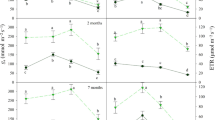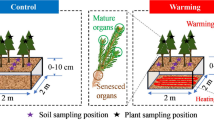Abstract
In neotropical alpine grasslands (páramo), the natural tussock grass vegetation is extensively grazed and occasionally burned. The low productivity of the tussock grass seems to be the reason for the disappearance of this growth form in the most frequently intervened areas. The structure, microclimate and leaf elongation rates of new emerging leaves were studied for the dominant tussock grass species Calamagrostis effusa, at an undisturbed, a moderately grazed (7 year after fire) and a heavily grazed (3.5 years after fire) site. In absence of grazing and burning, the tussocks had a high standing crop (1.07±0.09 kg DW · m-2) and leaf area per projected tussock cover (LAI: 9.6±1.4). Two thirds of the total mass was dead and more than half of the leaves were in horizontal position. The tussock growth form protects the meristems from severe climatic conditions. At midday, the temperature was higher at meristem level than in the rest of the tussock. At this level, photosynthetic irradiance (PI) was almost extinct at 2.9±0.74% of PI above the vegetation. The red/far red ratio (R/FR) was strongly decreased. Initial leaf elongation of new born leaves was 2.3 mm · day-1, and constant during the year; estimated net annual production was 198±73.8 g m-2. At the moderately grazed and the heavily grazed study sites, the tussocks were smaller, greener and more erect than those at the undisturbed site. More PI reached the meristems and R/FR was higher at the base of grazed tussocks. Leaf elongation rates were lower. Most of the litter disappeared during the fires. The lower elongation rate of leaves in the grazed areas might be a response to defoliation, resulting in increased tillering and a lack growth associated with poor temperature insulation and more UV-B damage.
Similar content being viewed by others
References
Barkman, J. J. 1979. The investigation of vegetation texture and structure. In: Werger, M. J. A. (ed). The Study of Vegetation, pp. 125–160. Dr. W. Junk Publ., The Hague.
Barkman, J. J. & Stoutjesdijk, Ph. 1992. Microclimate, vegetation and fauna. Obulus, Uppsala.
Beck, E. 1987. Effect of supercooling and freezing on photosynthesis of freezing tolerant leaves of Afro-alpine “giant rosette” plants. In: Rundel, P., Meinzer, F. & Smith, A. P. (eds), Tropical Alpine Environments; Plant Form and Function, pp 366–371. Springer Verlag. Berlin.
Beck, E., Senser, M., Scheibe, R., Steiger, H. M. & Pongratz, P. 1982. Frost avoidance and freezing tolerance in Afroalpine “giant rosette” plants. Plant, Cell & Environment 5: 215–222.
Bodner, M. & Beck, E. 1987. Effect of supercooling and freezing on photosynthesis in freezing tolerant leaves of Afroalpine “giant rosette” plants. Oecologia 72: 366–371.
Briske, D. D. & Anderson, V. J. 1992. Competative ability of the bunchgrass Schizachyrium scoparium as affected by grazing history and defoliation. Vegetatio 103: 41–49.
Caldwell, M. M., Dean, T. J., Nowak, R. S., Dzurec, R. S. & Richards, J. H. 1983. Bunchgrass architecture, light interception, and water use efficiency. assessment by fiber optic point quadrats and gas exchange. Oecologia 59: 178–184.
Caldwell, M. M. & Robberecht, R. R. 1980. A steep latitudinal gradient of solar ultraviolet-B radiation in the arctic-alpine life zone. Ecology 61: 600–611.
Caldwell, M. M., Robberecht, R. R., Nowak, R. S. & Billings, W. D. 1982. Differential photosynthetic inhibition by ultraviolet radiation in species from the Arctic-Alpine life zone. Arctic and Alpine Research 14: 195–202.
Cardozo, C. H. & Schnetter, M. L. 1976. Estudios ecológicos en el Páramo de Cruz Verde, Colombia. III. La biomasa de tres asociaciones vegetales y la productividad de Calamagrostis effusa (H.B.K.) Steud. y Paepalanthus columbiensis Ruhl. en comparación con la concentración de clorofila. Caldasia 11(54): 85–91.
Chapin, F. S.III, Van, Cleve, K. & Chapin, M. C. 1979. Soil temperature and nutrient cycling in the tussock growth form of Eriophorum vaginatum. Journal of Ecology 67: 169–189.
Cleef, A. M. 1981. The vegetation of the páramos of the Colombian Cordillera Oriental. Dissertaciones Botanicae 16. J. Cramer, Vaduz.
Coe, M. J. 1967. The ecology of the alpine zone of Mount Kenya. Dr. W. Junk Publishers, The Hague.
Cuatrecasas, J. 1958. Aspectos de la vegetación natural. Revista de la Academica Colombiana de Ciencias Exáctas, Físicas y Naturales 10(40): 221–264.
Deregibus, V. A., Sanchez, R. A., Casal, J. J. & Trlica, M. J. 1985. Tillering responses to enrichment of red light beneath the canopy in a humid natural grassland. Journal of Applied Ecology 22: 199–206.
Fitter, A. H. & Hay, R. K. M. 1981. Environmental physiology of plants. Academic Press, London.
Fliervoet, L. M. & Werger, M. J. A. 1984. Canopy structure and microclimate of two wet grasslands comunities. New Phytologist 96: 115–130.
Gitay, H., Wilson, J. B., Lee, W. G. & Allen, R. B. 1991. Chionochloa rigida tussocks thirteen years after spring and autumn fire, Flagstaff, New Zealand. New Zealand Journal of Botany 29: 459–462.
Goldstein, G. & Meinzer, F. 1983. Influence of insulating dead leaves and low temperatures on water balance in an Andean giant rosette plant. Plant, Cell & Environment 6: 649–656.
Greig-Smith, P. 1964. Quantitative plant ecology. Butterworths, London.
Hadley, E. B. & Kieckhefer, B. J. 1963. Productivity of two prairie grasses in relation to fire frequency. Ecology 44: 389–395.
Hedberg, O. 1964. Features of Afro-Alpine plant ecology. Acta Phytogeographica Suecica 49: 1–144.
Hofstede, R. G. M. & Witte, H. J. L. 1993. An evaluation of the use of the Dry-Weight-Rank and the Comparative Yield biomass estimation methods in páramo ecosystem research. Caldasia 17(2): 11–14.
Hnatiuk, R. J. 1978. The growth of tussock grasses on an equatorial high mountain and on two sub-antartic islands. pp. 159–190. In: Troll, C., & Lauer, W. (eds), Geoecological relations between the southern temperate zone and the tropical mountains. Erdwissenschaftliche Forschung 11. Franz Steiner Verlag, Wiesbaden.
Hnatiuk, R. J. 1993. Grasslands of the sub-antarctic islands. pp. 411–434. In: Coupland, R. T. (ed), Natural Grasslands (Eastern Hemisphere). Ecosystems of the World, Vol. 8B. Elseviers Science Publ., Amsterdam.
Lee, D. W. & Lowrey, J. B. 1980. Solar ultraviolet on tropical mountains: Can it affect plant speciation? American Naturalist 115: 80–83.
Lee, W. G., Mills, J. A. & Lavers, R. B. 1988. Effect of artificial defoliation of mid-ribbed snow-tussock, Chionochloa pallens, in the Murchioson Mountains, Fiordland, New Zealand. New Zealand Journal of Botany 26: 511–523.
Mark, A. F. 1965. Effects of management practices on narrow-leaved snow tussock, Chionochloa rigida. New Zealand Journal of Botany 3: 300–319.
Mark, A. F. 1993. Indigenous grasslands of New Zealand. pp. 361–410. In: Coupland, R. T. (ed), Natural Grasslands (Eastern Hemisphere). Ecosystems of the World, Vol. 8B. Elseviers Science Publications, Amsterdam.
Monasterio, M. & Sarmiento, L. 1991. Adaptive radiation of Espeletia in the cold Andean tropics. Trends in Ecology and Evololution 6(12): 387–391.
Monsi, M., Uchijima, Z. & Oikawa, T. 1973. Structure of foliage canopies and photosynthesis. Annual Review of Ecology and Systematics 4: 301–307.
Payton, I. J. & Mark, A. F. 1979. Long term effects of burning on growth, flowering, and carbohydrate reserves on narrowleaved snow tussock (Chionochloa rigida). New Zealand Journal of Botany 17: 43–54
Rada, F., Goldstein, G., Azocar, A. & Meinzer, F. 1985. Freezing avoidance in Andean giant rosette plants. Plant, Cell & Environmen 8: 501–507.
Rada, F., Gonzalez, J., Azocar, A., Brice-o, B. & Jaimez, R. 1992. Net photosynthesis-leaf temperature relations in plant species with different height along an altitudinal gradient. Acta Oecologica 13: 535–542.
Robberecht, R. R. & Caldwell, M. M. 1978. Leaf epidermal transmittance of ultraviolet radiation and its implications for plant sensitivity to ultraviolet-radiation induced injury. Oecologia 32: 277–287.
Robberecht, R. R., Caldwell, M. M. & Billings, W. D. 1980. Leaf ultraviolet optical properties along a latitudinal gradient in the arctic-alpine life zone. Ecology 61: 612–619.
Salamanca V., S. 1991. The vegetation of the páramo and its dynamics in the volcanic massif Ruiz-Tolima (Cordillera Central, Colombia). Ph.D. Dissertation, University of Amsterdam.
Schmidt, A. M., Verweij, P. A. 1992. Forage intake and secondary production in extensive livestock systems in páramo. pp. 197–210. In: Balslev, H. & Lutyen, J. L. (eds), Páramo; An andean ecosystem under human influence. Academic Press, London.
Smith, A. P. 1979. Fuction of dead leaves in Espeletia schultzii (Compositae), an Andean giant rosette species. Biotropica 11: 43–47.
Smith, A. P. & Young, T. P. 1987. Tropical alpine plant ecology. Annual Review of Ecology and Systematics 18: 137–158.
Sokal, R. R. & Rohlf, F. J. 1981. Biometry, 2nd ed. W.H. Freeman and Company, New York.
Tol, G.J. & Cleef, A.M. in press. Above-ground biomass structure of a Chusquea tesselata bamboo páramo, Chingaza National Park, Cordillera Oriental, Colombia. Vegetatio.
Troll, C. 1968. The Cordilleras of the tropical Americas. pp. 15–56 In: Troll, C. (ed), Geo-ecology of the mountainous regions of the tropical Americas. Ed. Ferd. D<Yuml>mmlers Verlag, Bonn.
U. S. Department of Agriculture. 1975. Soil Taxonomy. Agricultural Handbook No. 436, Washington, D.C.
Van Loo, E. N. 1993. On the relation between tillering, leaf area dynamics and regrowth of perennial ryegrass (Lolium perenne L.). Ph.D. Dissertation, Agricultural University, Wageningen.
Verweij, P. A. & Budde, P.E. 1992. Burning and grazing gradients in páramo vegetation. an initial ordination analysis. pp. 177–195. In: Balslev, H. & Luteyn, J. L. (eds), Páramo; An andean ecosystem under human influence. Academic Press, London.
Verweij, P.A., Kok, K. & Budde, P.E. (in press). Human impact in páramo. In: Van Der Hammen, T. & Dos Santos, A.G. (eds), Studies on Tropical Andean Ecosystems 4. J. Cramer, Berlin/Stuttgart.
Vis, M. 1989. Processes and patterns of erosion in natural and disturbed Andean forest ecosystems. Ph.D. Dissertation, University of Amsterdam.
Witte, H. J. L. (in press). Seasonal and altitudinal distribution of precipitation, temperature and humidity in the Parque Los Nevados Transect (Cordillera Central, Colombia). In: Van Der Hammen, T. & Dos Santos, A. G. (eds), Studies on Tropical Andean Ecosystems 4. J. Cramer, Berlin/Stuttgart.
Author information
Authors and Affiliations
Rights and permissions
About this article
Cite this article
Hofstede, R.G.M., Chilito, E.J.P. & Sandovals, E.M. Vegetative structure, microclimate, and leaf growth of a páramo tussock grass species, in undisturbed, burned and grazed conditions. Vegetatio 119, 53–65 (1995). https://doi.org/10.1007/BF00047370
Accepted:
Issue Date:
DOI: https://doi.org/10.1007/BF00047370




